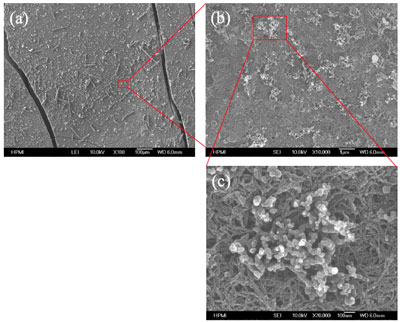| Posted: Jun 07, 2010 | |
Buckypaper improves fire retardancy of plastic materials |
|
| (Nanowerk Spotlight) Flame retardant materials have become a major business for the chemical industry and can be found practically everywhere in modern society. Unfortunately, conventional methods for making plastic flame retardant involve a range of often very toxic chemicals. In a previous Nanowerk Spotlight we have shown how improving the flame retardancy of polymeric materials without the use of toxic chemicals could now become possible thanks to the synergistic effect of nanoclay and carbon nanotubes ("Flame-retardant materials with more nanotechnology and less toxic chemicals"). | |
| Researchers have now shown that the use of buckypaper – macroscopic aggregates of intertwined CNTs in which the nanotubes collectively behave as a random web – is more efficient as a fire retardant in polymer composites in comparison to directly mixing carbon nanotubes (CNTs) into the composite matrix. | |
| "Given the importance of the fire retardancy of high-performance/high-temperature polymers, the main objective of our study is to improve the fire retardancy of polyimide matrix composites using CNTs" says Ben Wang, Simon Ostrach Professor of Engineering at Florida State University and director of the High-Performance Materials Institute. | |
| Wang and his team examined the idea of using mixed single-walled and multiwalled CNT buckypaper to improve the fire retardancy of polyimide/carbon fibre composites. | |
| Reporting their findings in the upcoming issue of Nanotechnology ("Carbon nanotube buckypaper to improve fire retardancy of high-temperature/high-performance polymer composites"), first authored by Xiang Fu, they found that the mixed SWCNT/MWCNT buckypaper incorporated on a composite surface yielded longer times to ignition, lower heat release rate, less total heat release, less smoke and less mass loss compared to the neat polyimide/carbon fibre composites. | |
| According to the team, the buckypaper was far more efficient as a fire retardant in fibre/polymer composites than MWCNTs that were directly mixed with the polyimide resin. The buckypaper survived the burning test as a fire retardant shield with ash deposited on the burned composite surface. They conclude that the buckypaper acted as a shielding layer, obstructing the flow of heat and oxygen to the inner polymer matrix. | |
 |
|
| SEM images of the top surface of the buckypaper/polymer residue: (a) 100×, (b) 10 000× magnified image of the marked area in (a); (c) 70 000× magnified image of the marked area in subfigure (b). (Reprinted with permission from IOP Publishing) | |
| To fabricate their buckpaper, the researchers purchased SWCNTs and MWCNTs off the shelf and used them without further purification. Through grinding and mixing with de-ionized water they formed a thick paste which they subsequently diluted, sonicated and filtrated through a nanomembrane (450 nm pore size) under vacuum pressure. Buckypaper with a thickness of 40 µm remained on the membrane and could then be peeled off. | |
| The surface of the buckypaper indicates that it mainly consists of large-diameter MWCNTs interwoven with smaller-diameter SWCNTs. | |
| The scientists explain that the high thermal conductivity of buckypaper allows quick heat transport along the buckypaper by means of phonons and makes it hard to accumulate heat energy. | |
| "The extremely high surface area of the buckypaper also leads to excessive radial heat radiation. The high thermal conductivity and high surface area explain why, in principle, buckypaper has high thermal conductivity." | |
| By conducting burn tests with different materials, the team found that, compared to a control sample of regular polymer composite (carbon fiber and polyimide), the sample with MWCNTs mixed in resin yielded delayed ignition (18 s longer to ignition), 38% lower peak heat release rate, 3.7% lower total heat release, 28% more total smoke release and equivalent total mass loss. However, the buckypaper incorporated sample produced further delayed ignition (38 s longer to ignition), 40% lower peak heat release rate, 26% lower heat release, 82% less smoke release and 33% less mass loss compared to the control sample. | |
| The buckypaper remained intact on the composite surface, whereas the sample with directly mixed CNTs in resin bulged up after the burning test. Also, after the burn, the buckypaper remained as a shielding layer with floccules left on the upper surface (see above figure). | |
| Wang's team concludes that the use of buckypaper is more efficient as a fire retardant in polyimide/carbon fibre composites in comparison to directly mixing CNTs into the composite matrix. "The buckypaper incorporated composite brought about further delay of ignition, lower heat release rate, lower heat release, lower mass loss and much less smoke release compared to the composite with MWCNTs mixed in resin. | |
 By
Michael
Berger
– Michael is author of three books by the Royal Society of Chemistry:
Nano-Society: Pushing the Boundaries of Technology,
Nanotechnology: The Future is Tiny, and
Nanoengineering: The Skills and Tools Making Technology Invisible
Copyright ©
Nanowerk LLC
By
Michael
Berger
– Michael is author of three books by the Royal Society of Chemistry:
Nano-Society: Pushing the Boundaries of Technology,
Nanotechnology: The Future is Tiny, and
Nanoengineering: The Skills and Tools Making Technology Invisible
Copyright ©
Nanowerk LLC
|
|
|
Become a Spotlight guest author! Join our large and growing group of guest contributors. Have you just published a scientific paper or have other exciting developments to share with the nanotechnology community? Here is how to publish on nanowerk.com. |
|
